|
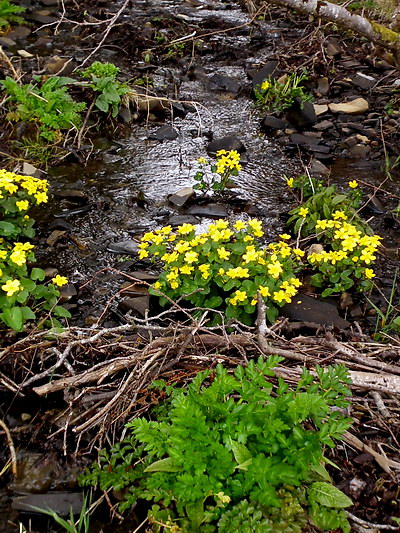
|
NW Corner of Ross Beg bay.
A small dark clear stream enters the Lake from a ditch in a valley between two sloping fields. It is full of black flat rocks and other more blocky grey and brown limestones and sandstones, which may not be of local origin.
|
Is the rock what is Special?
This photo shows thick bands of very thinly bedded shale overlying a narrow band of limestone. These shales are called Belavalley Shales and are infrequently exposed around the shores of Lough Allen. They are very thin and, hopefully, of no use for fracking!
These shales are described as calcareous, i.e rich in Calcium or lime. Much of Lough Allen is acidic and the water was regarded as oligotrophic (lacking in nutrients). In certain areas such as this the acid/base balance may be changed by local outcrops of scarce limey rocks
|
|
|
|
|
|
|
|

|
Geology.
A close up of some of the shale with strands of Ivy running over it. This shale is very crumbly and large parts of some beaches at the north end of Lough Allen can be made up of black ‘shingle’ emanating from fragments of shale being eroded from exposed shores like Corry and around Spencer Harbour. In small fagments this material is easily carried by wave action and currents.
|
A Siskin
Siskins are common birds that come to bird tables in a conspicuous way in Winter. But they are a bird of forests, both coniferous and natural woods. They love Alder catkins and in early Spring can be seen feeding on these in wooded areas bordering Lough Allen. They also will alight near the water and, while they may be seeking water, they may also be picking up washed up seeds during the lean Winter season.
|

|
|
|
|
|
|
|
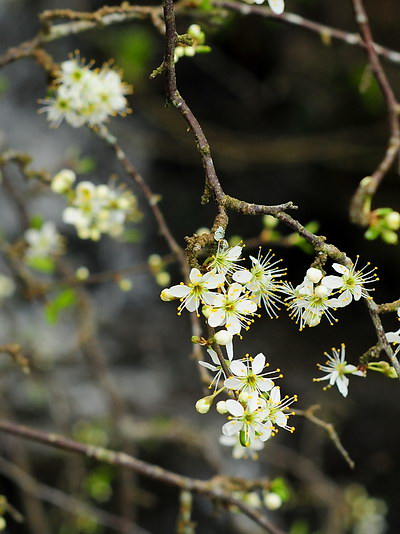
|
Blackthorn
A Blackthorn flowering late in a slow Spring. This specimen is growing over a smal waterfall at the back of the shore where many Mosses, Liverworts and Golden Saxifrage thrive. Is this a source of lime for these species?
The Blackthorn like the Butterbur and Coltsfoot (see below) is another plant that chooses to flower before it has any leaves. It seems strange as they are flowering at a time when there are few insects to pollinate. Also it is very debatable whether the Butterbur ever reproduces sexually in this climate?
|
Stalactites of Water
We took this photo (in late February) on quite a warm and sunny day! It was surprising to come around a corner and see such a frozen world — reflects the cold nights at that time.
Interestingly this was at the base of high cliffs and the icicles indicate the amount of water, which might otherwise not be noticed, coming from here and entering the lake...
|
|
|
|
|
|
|
|

|
The Star of the show!
This is a Butterbur flower forcing its way up through sand. These plants emerge every year in that very cold period between Winter and Spring. It is hard to see the rationale for this. They are not saprophytes (feeding on dead tissue) and are photosynthetic producing leaves after the flowers are fully grown.
This is the only site around Lough Allen where we have seen this plant. So, any other observations, would be very welcome? It is easily recognised and flowers from March to May.
|
Butterbur
This is one of the best pictures we have of this plant. It mainly propagates vegetatively. i.e. through rhizomes storing nutrients and by a system of underground runners. It always seems to occur near water and in light soils such as the sand shown here.
There is some debate as to whether this species is separately male or female or inclined towards both as the mood takes it! There are subtle differences between the male and female flowers but all the specimens we have seen have had male flowers such as shown here!
This pattern of growth and reproduction may be one of the reasons for the very local distribution of this plant. It would be interesting to know why they occur in this remote spot and how they got there. Perhaps a piece of rhizome washing down the Shannon?
|

|
|
|
|
|

|
Detail of a Floret.
This is just one of the individual flower heads from a flowering stem like the one shown on the right. The length of this flower head from stalk to tip is hardly more than 2 cm. but the flowering stems and leaves may be huge in female plants, reaching up to 1 or 2 metres. (Female plants have not been found in Lough Allen)
This would appear to be a male plant. The white structure shown on the left is a stamen (male plant organ) surrounded by petals on a single flower within the flowering head. This species has many individual tiny florets within multiple flowering heads on each tall flowering stem!
Some people say that these flowering heads may contain both male and female elements; other people claim that it is separate flowering heads that are male or female; and more people say that the female plants rarely occur in our latitudes and the species survives solely by vegetative reproduction!
|
|
|
|
|
|
|
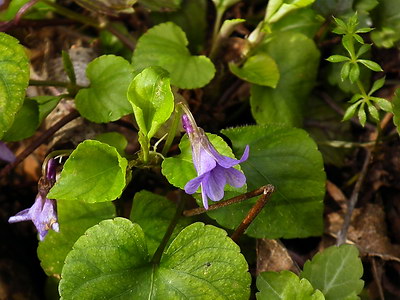
|
Wood Violet
An early flowering variety of Violet which normally occurs in woods and banks. Many violets like limey soils and this one is very common around Lough Allen shores.
The Wood Dog Violet (Viola reichenbachiana is its Latin rather Sherlock Holmes’y name!) has a straight purple spur, the part of the flower pointing backwards.
|
Month later...
This clump of Wood Violets is thriving possibly because of the presence of limestone rocks? The bright leaves and vivid flowers are typical of flowers in a mineral rich substrate.
|

|
|
|
|
|
|
|

|
Liverwort
(Species to be identified.) Liverworts are fascinating plants of the Bryophyta classification of Plants.
They occur everywehere around Lough Allen but may be hard to see as they like wet dark places like rocky channels and densely overgrown streams. In areas of shade and permanent moisture the individual ‘leaves’ can grow to quite a large size.
|
Robin
They always seem to be watching, wondering what we find so fascinating with those plants on the ground!
|

|
|
|
|
|
|
|

|
Liverwort spores.
At this time of year these little capsules appear at the tip of a very long filament (5cm.) They are tiny and very delicate and very hard to photograph but well worth looking out for in early May.
|
Golden Saxifrage
Saxifrages, beloved of rock gardeners are a widespread group of plants often with red or white flowers. This species has yellow flowers without petals, the typical yellow among bright green appearance coming from the sepals.
This is the common opposite-leaved form of Golden Saxifrage which is frequent on rocks and cliffs and in wet woodlands, where it can form dense mats.
|
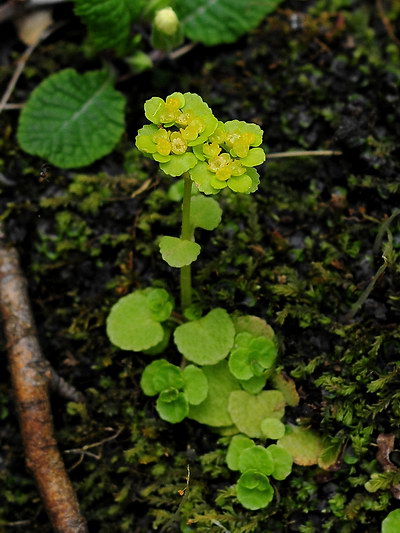
|
|
|
|
|
|
|
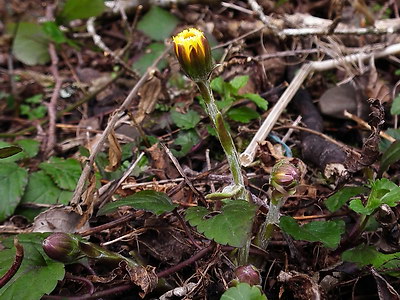
|
Coltsfoot
A widespread plant but, like the Buttterbur above, it also emerges and flowers before it produces leaves. Superficially the flower may resemble a Dandelion but it has heart shaped leaves as opposed to the lions teeth of the Dandelion.
This photograph is from March when the Coltsfoot and the Butterburs were just emerging.
|
Coltsfoot flowers
A very beautiful flower when fully open. It is more raggedy and even a brighter yellow. These plants are typical of dry stony, sandy, or waste areas.
|

|
|
|
|
|
|
|
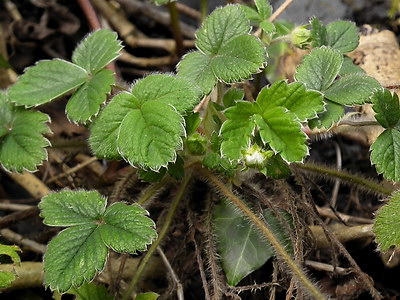
|
Barren Strawberry
So called because its fruit, though present, is inedible. This species comes out earlier than the Wild Strawberry and its leaves are much hairier.
It was found in drier areas away from the stream and typically would be found among brambles and exposed to the sun. Not a specific plant of the wet limey lake margins like some of the other speicies listed.
|
Barren Strawberry flowering
Almost a synthetic or silk-like flower but strangely appealing. Replaced later in the year, in hedges and ditches, by Wild Strawberry with all its gorgeous little fruits.
|

|
|
|
|
|
|
|
BELOW: Marsh Marigold in early Spring.
A luxuriant prolific flowering plant of wet marshy and lime-rich areas, this plant may be a good guide to where alkaline water
is leaching into Lough Allen along shale or mudstone lined streams. It has no petals and the bright flowers are composed of 5 sepals.
|
|
|
|
|
|
|
|
|

|
Portrait of
Golden Saxifrage.
Just a view of a larger area of this species showing its ground covering qualities and its attractive green and yellow display in Spring.
|
Common Redpoll
Like the Siskin, shown above, this species is also widespread but easily missed. By and large, Linnets do not occur in Leitrim and any small finches with a streaky brown breast are likely to be this species. The black bib is characteristic with both sexes having a red cap and the male a red chest in Summer
Seen in flocks, along with Siskins and Long-tailed Tits, in trees along this shore, the Alder being one of their favourites — the Alder is actually a rather important tree!
|

|
|
|
|
|
|
|

|
Redcup Fungus
A typical saprophyte often found on decaying branches in wet woodland, adds a bit of colour to these places in Winter.
Here it is attractively set off against a young Speedwell specimen.
|
The Shore
This shows the shore just below this habitat. A variety of rocks can be seen here, sandstone with the sharp edges, mudstones (limestone) with the dimples, and shale flat slabs
All thee rocks could be local in origin, but typically of Lough Allen, they could also have originated further away and been carried here by ice. The islands of Lough Allen, and many surrounding hills, are Drumlins composed of boulders and grit carried there by Glaciers in 2010 — well, a bit earlier!
|
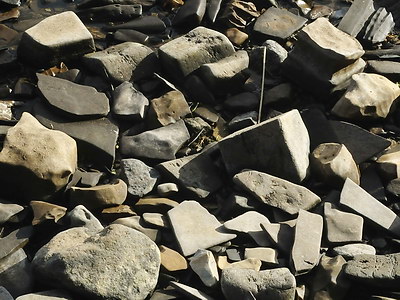
|
|
|
|
|
|
|
View from Special Place No. 1
Just looking south east from this site, this is the view we often get looking out. Frequently this site is visited by boat (as it is a bit remote) and
this is the view one can enjoy heading home after a visit. Ross Beg is the headland in the middle distance with Slieve an Iarainn behind.
|
|
|
|
|
|
|
|
|
|
|
|
|
|
|
|
|
|